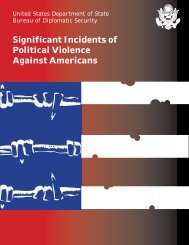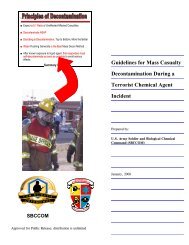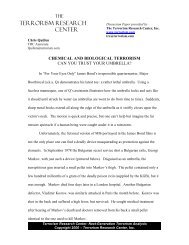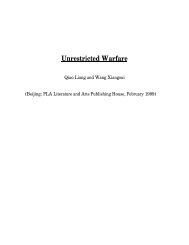Combating Proliferation of Weapons of Mass Destruction
Combating Proliferation of Weapons of Mass Destruction
Combating Proliferation of Weapons of Mass Destruction
Create successful ePaper yourself
Turn your PDF publications into a flip-book with our unique Google optimized e-Paper software.
Senate, and who is also dual-hatted as the President’s Science Advisor. The extent <strong>of</strong>OSTP’s engagement in proliferation matters depends in large measure on the interest andcommitment <strong>of</strong> the individual in this position.OSTP’s proliferation-related activities are conducted in the National Security andInternational Affairs (NSIA) Division. The Division is headed by an Associate Director whois subject to Senate confirmation and is dual-hatted as Senior Director for Science andTechnology (S&T) on the National Security Council staff. The NSIA Division develops andsupports science and technology policy in national security, the commerce-security nexus,and international affairs. The Division’s National Security staff consists <strong>of</strong> four persons, all<strong>of</strong> whom hold advanced degrees in science or technology. The previous AssociateDirector, herself a Ph.D. in biochemistry and biophysics, estimated that 25 percent <strong>of</strong> thatgroup’s work was devoted to proliferation-related issues.Participation in the Interagency Policy Process. As a consequence <strong>of</strong> its policy focusand significant scientific and technical expertise, yet small staff, OSTP’s involvement inproliferation matters occurs primarily through participation in interagency activities.The Associate Director is a member <strong>of</strong> the IWG on Non-<strong>Proliferation</strong> and Export Controls,through which OSTP has been involved in Administration efforts to arrange the disposition<strong>of</strong> Russian excess weapons-grade plutonium, to facilitate a domestic consensus and theimplementation <strong>of</strong> a strategy for the disposition <strong>of</strong> U.S. weapons-grade plutonium, and tomonitor implementation <strong>of</strong> the highly enriched uranium (HEU) purchase agreement andthe blend down <strong>of</strong> U.S. HEU. The Associate Director formerly co-chaired, with an NSCDirector for Non-<strong>Proliferation</strong> and Export Controls, the IWG’s sub-group on PlutoniumDisposition. OSTP remains an active member <strong>of</strong> this group. (OSTP also co-chairs with theRussian Ministry <strong>of</strong> Atomic Energy (MINATOM) the U.S.-Russian Plutonium DispositionJoint Steering Committee to oversee R&D cooperation in this area.) OSTP participates inother sub-groups <strong>of</strong> the IWG on Non-<strong>Proliferation</strong> and Export Controls, including the Sub-Group on Biological <strong>Weapons</strong> and the Sub-Group on Chemical <strong>Weapons</strong>.The Associate Director, in her role as NSC Senior Director for S&T, chairs the Researchand Development (R&D) Sub-Group <strong>of</strong> the WMD Protection, Consequence Managementand Preparedness Panel established under PDD-62. This group examines how best todeploy U.S. scientific and technical capabilities to prevent, detect, mitigate against,respond to, and/or recover from terrorist attack, with special attention to possible terroristuse <strong>of</strong> chemical and biological weapons.In the area <strong>of</strong> ballistic missile proliferation, OSTP is working with CIA experts to understandthe major technological hurdles to the development <strong>of</strong> ICBMs and, in particular, the addeddifficulty <strong>of</strong> developing ICBMs, as compared to shorter range missiles. Also, in the wake <strong>of</strong>the Indian and Pakistani nuclear weapon tests, OSTP is leading an interagency effort toevaluate and recommend policy with respect to on-going collaborations with thesecountries.23







